Winifred Wells 2
Winifred Wells, Australia’s First Lady
Solo back-to-back transcontinental rides put Winifred Wells on the map, her circuit of Australia confirmed her eminence among moto pioneers.
When I was eleven years old I stood in the Kitchen and said, I want a motorbike.
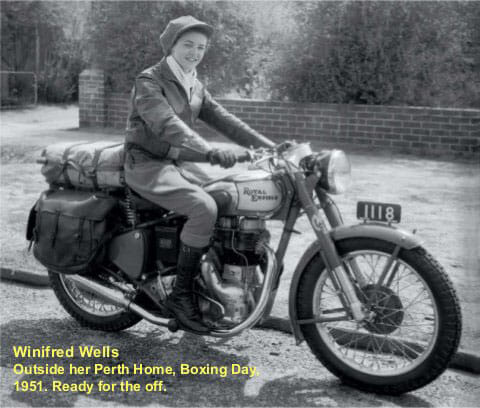
Picture: Winifred Wells outside her Perth home, Boxing Day 1951. Ready for the off.
Of course, my parents laughed and said, later dear, but I knew what I wanted. Hence by the time Winifred Wells, daughter of a furniture manufacturer from Shenton Park, Perth, was old enough to obtain a riders license, much to her parents’ consternation she had also acquired a 250cc BSA, and twelve months later, she used that same determination on the committee of the local motorcycle club.
“I got thrown off the bike when a chap threw a ‘Uey’ in front of me and I went flying. I realised I needed to learn more about riding so I went and joined the local club. They didn’t want me. They didn‘t want a woman. Typical male chauvinism!”
Inevitably Winifred convinced them otherwise, and moved up to a 350cc Triumph Tiger 80 and was soon a regular on club rides, and at the habitual club bull sessions.
“We used to toss things around,” recalls Winifred “you know how bike riders are, all have different opinions. You couldn‘t ride across the Nullabor, you‘d blow the bike up. No you wouldn’t, yes you would backwards and forwards blah, blah, blah,”
“Now Carlyle and Co. were electrical people but they had the Enfield agency In Perth. The owner Carl Cohen Knew Matchless and Norton were much more favoured machines but he was very approachable and, as a businessman, he could see the merit in my proposal to ride an Enfield across the Nullarbor Desert.
Her Journey began on Boxing Day 1951, when she set out from Perth at noon having loaded her 350cc. Enfield ‘Bullet’ with provisions and spare clothing in pannier bags and a carrier borne suitcase. In her pocket was £25.00 which was all she allowed herself for her three week holiday. She wore riding boots, fawn britches, blue sweater, leather jacket, and a old tweed cap.
It being high summer in Australia there was no need for waterproofs, on the contrary, most of the journey was done under conditions of scorching heat. “I was so full of myself as you are at 22,” admits Winifred, “but I was going to ride to Sydney and then ride back.” Fellow club members couldn‘t dissuade her by predicting ‘white mettle bearings’ would self destruct or that she’d perish on the Nullarbor.
Her first day’s run took her to the small town of Southern Cross, the following morning she began the most gruelling part of her itinerary, the crossing of Nullarbor Plain.
Possibly, all Carl Cohen could see was a very determined and very pretty blue eyed young lady and though he sponsored the undertaking to the tune of twenty five quid, he was businessman enough to sign Winifred up on the never-never the new Royal Enfield Bullet 350 would only become hers after she’d made the final payment. In fact, Winfred had to obtain permission from the financier IAG to take the bike out of The State of Western Australia.
The Township of Norseman was reached safely but the following night found her out in the blue with human habitation nowhere nearer than at least a hundred miles. She had intended to reach Eucla, but a skid on loose gravel had shaken her somewhat and she did not feel well enough to press on, “So” she explained later, “I used my bike and groundsheet to rig a shelter in the bush. It was the loneliest hole you ever saw.”
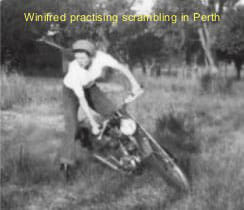
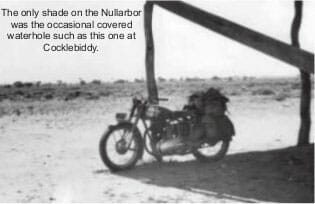
Even a bad fall on the second day didn’t deter her. “I was haring down those terrible corrugations and had the biggest spill you could imagine, a full locker and high side that sent me sprawling.” “It was near Spargoville, one of those mining settlements that had sprung up in the goldfields, and a motorist tried to convince me to return to Perth.
He was quite distressed because I’d wiped the side of my face off and also cracked my head. I’d also done a bit of damage to the bike but the garage in Norseman gave me a bit of a hand with the bike and that was that.”
Picture left: Back in Perth after travelling 5500 miles in 21 days, Winnie receives a hero’s welcome.
Picture right: At the completion of her solo ride to Sydney and back to Perth, Winifred was presented with a silver cup, air freighted from England by the Enfield cycle Co, at the Claremont Speedway
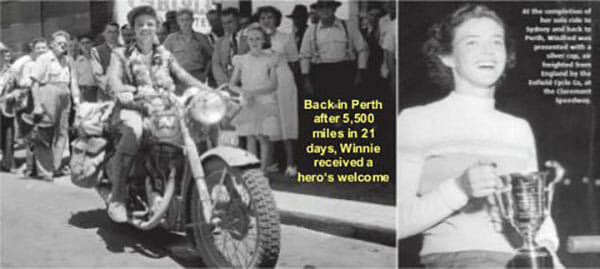
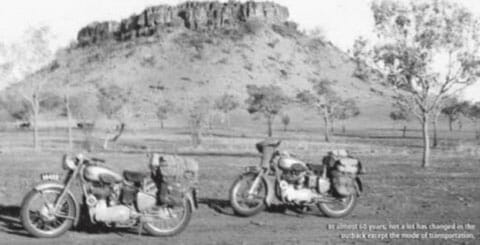
Picture: In almost 60 years, not a lot has changed in the outback except the mode of transportation.
Throughout the transcontinental crossing Winifred carried all before her, none more so than George Bolton, Adelaide’s Royal Enfield Distributor who wrote on her return journey; Winifred left carrying our best wishes and prayers that she would get through safely.
When she left Adelaide the temperature was 105 degrees F (about 40 degrees C) and rising, and our hopes were high that this gallant little sole will win out. As if there was any doubt. After 5,500 miles in 21 days, Winifred was back where she started.
On returning to Perth Winifred was congratulated by Lord Mayor Joe Totterdell and whilst the press stuck to the basics, the popular People magazine reported: For days on end Winifred averaged no more than one meal a day and her normal weight of 7st 13lb dropped few pounds. The blue-eyed, small-faced young woman is 5ft 5in tall, has a trim, well shaped figure, good legs and wiry wrist.
Her stay in Sydney lasted only from the Friday night to the following Sunday morning, but in that time she ‘took in’ most of the sights including King’s Cross and nearby beauty spots in the luxury of a friend’s car whilst wearing a smart dress and high heels. Few overlanders who had seen her ‘on the track’ only days before would of recognised the well turned out young woman.
Winifred declared she’d had enough of the dust but continued to ride regularly on the Bullet, for which the Royal Enfield distributors around Australia had chipped in for a presentation to acknowledge her feat7#45; along with fancy silverware from home and the Royal Enfield HQ in Britain.
“It didn’t take long before I was keen to travel again,” says Winifred “this time around Australia, but my father said ‘ this time you’re not going alone.’ Just as well too.
It’s a very different country up north.” George, who’d been a motor cyclist since 1910, and had owned an eclectic list of machines including an Indian outfit, a Rudge and an Ivory Calthorpe, was quite aware of how headstrong his daughter was.
He was also aware he’d only be able to match Winifred’s skills in the technical country. But importantly, because he’d spent some time working the Kimberly Coast as a marine engineer, he knew how ‘different’ it could be in the tropics.
Naturally, Winifred would score a new Bullet whilst George rode the venerable transcontinental veteran and, it appears, carried more than his share of the luggage, as any gentleman would. Hoping to cross the top before the annual big wet the duo rode north from Perth on 23 September 1952 and, in order to avoid all the huge haulage convoys carrying equipment up the coast for the atomic test on Monte Bello took the inland route.
They made good headway over well established, if not well formed tracks until they came to Le Grange and the dreaded Pardoo sands.
“Neither of us could seem to find the right speed or balance,” recalls Winifred. “It was the first time I thought ‘I can’t do this’ it was impossible.” And that was before one of the dust storms that regularly inhabit the Great Sandy Desert engulfed them for the best part of a day. But of course where there’s a will there’s a way and the pair ‘tonk, tonked’ their way through the sand and spinefex to Broome.
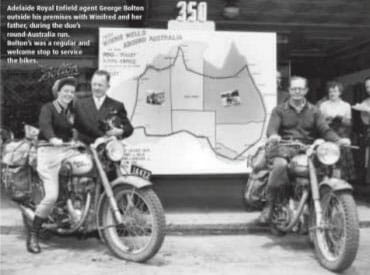
Picture: Adelaide Royal Enfield agent George Bolton outside his premises with Winifred and her father, during the duo’s round-Australia run. Bolton’s was a regular and welcome stop to service the bikes.
George was immediately accosted and rebuked for encouraging his daughter “a mere slip of a girl and certainly not buxom enough” to engage in such folly and George was hard put to convince his well intentioned critic that Winnie was indeed “the boss”.
Winifred remembers the six miles of bitumen on the way into Derby as sheer heaven, particularly after the trials of the ‘Pindan’ country and the notorious Yeeda crossing. She also recalls the Police in Derby being particularly officious about paperwork and demanding to know when the pair intended to leave town.
At the other spectrum, when the two machines rolled up to the Halls Creek Police Station – then some distance from the actual township – the local walloper was leaning over the front fence. By way of introduction, they stated who they were. The walloper looked them over, replied “I Know”, turned and entered the police station.
Expecting the worst, they continued on across the Northern Territory following the Victoria and the Dry Rivers, both were dry, on to Katherine and north to Darwin. “It was very rough” said Winifred, “and I’d never seen so many scrub bulls. But nothing we encountered was anywhere near as difficult as the Pardoo Sands.”
They had intended to visit Alice Springs but the 600 mile run down from Darwin to Tennant Creek had taken its toll on their rubber, and taking the narrow strip of bitumen heading east towards mount Isa proved more prudent if not irresistible.
Half way through their odyssey they arrived back in civilisation of sorts for a brief respite in Cairns before following the coast all the way south to Sydney.
No doubt on the long, more or less straight stretches Winifred indulged in her comfortable travelling style of both legs straddled across the petrol tank, considering that 60mph “was not unduly fast when the way was clear” and that 78mph was achievable. What father George thought of these practices were never recorded.
Back in the regions where publicity could generate sales of the Royal Enfield marque their pace slowed, not so much on the road, but simply for all the photographers to practice their livelihood and reporters to rub shoulders with someone who had actually achieved something to deserve it.
On her solo journey Winifred rode from Sydney to Perth in nine days, this time round it took nineteen; and it certainly wasn’t George whom the press wished to ogle.
In Adelaide, the enthusiastic George Bolton had mounted a virtual civic reception, right outside his showrooms, no doubt Winifred’s much publicised appearance did much to assist sales of ‘The Royal Enfield Bullet, as ridden by Winifred Wells.’ The accolades continued in Winifred’s home town, Perth, a city already preparing for the visit of Queen Elizabeth.
But Winnie the queen of the desert was back, prompting one of Australia’s better known journalist to write: Winifred is a dyed-in-the-wool and highly competent motorcyclist, possessing that rare combination of judgement, balance, feel for an engine and road sense… she is at all times thoroughly at home in the saddle and one of two active members A.J.S. M.C.C. Western Australia.
Possibly recognising the value of such a historical machine, Cal Cohen then relieved Winifred of her “original Bullet” but she kept her “round Australia” mount for some years as a daily ride: but the £1,000 award she was rumoured to have received was no more than an urban myth.
She did however acquire another bike, a J.A.P. “That’s the only time I wore a helmet and leathers. Four of us did the fire hoop show at the speed way and that’s the only time I wore a helmet.”
Then working for a group of seismologist at a major oil exploration company, Winifred was transferred to Queens Land. Simultaneously, a bout of pleurisy, which developed into pneumonia forced her to forego her love of motor cycling.
Little wonder then she took up flying, obtaining her private licence in Perth before graduating to a commercial licence at Archerfield. Her adventures in the air match her exploits on terra firma culminating in her navigating one of the winners in the last great Ansett Air Race around Australia.
Winifred’s aspirations of a motorcycle circuit racing denied, she maintains an active interest in all things motorcycling, noting that Mick Doolan was the last of the greats who really looked comfortable on a bike.
On the other hand Winifred’s eyes go a little dreamy when she mentions Geoff Duke on his Gelera, “it was poetry in motion.” We think Winifred may have inspired a little poetry in her time too.
Picture: The Mobil company provided some degree of assistance to the father and daughter.
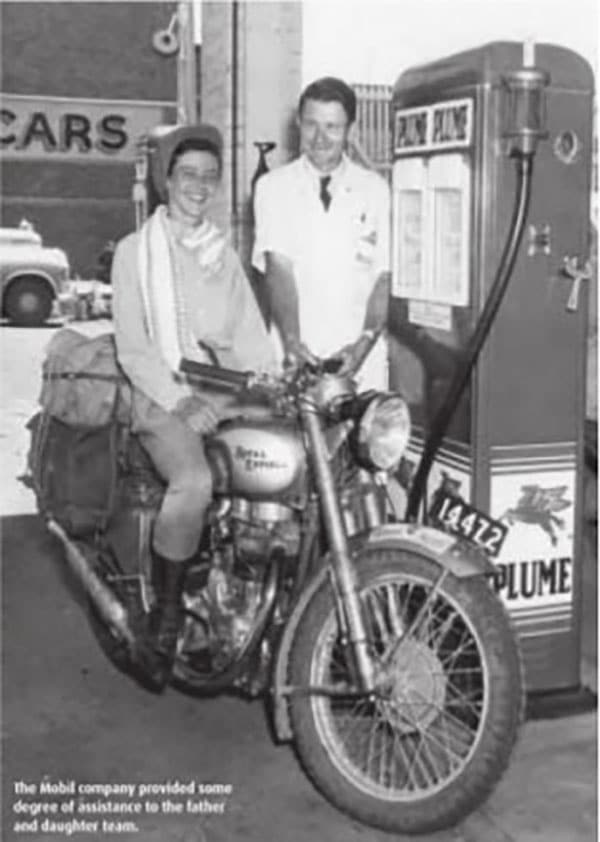
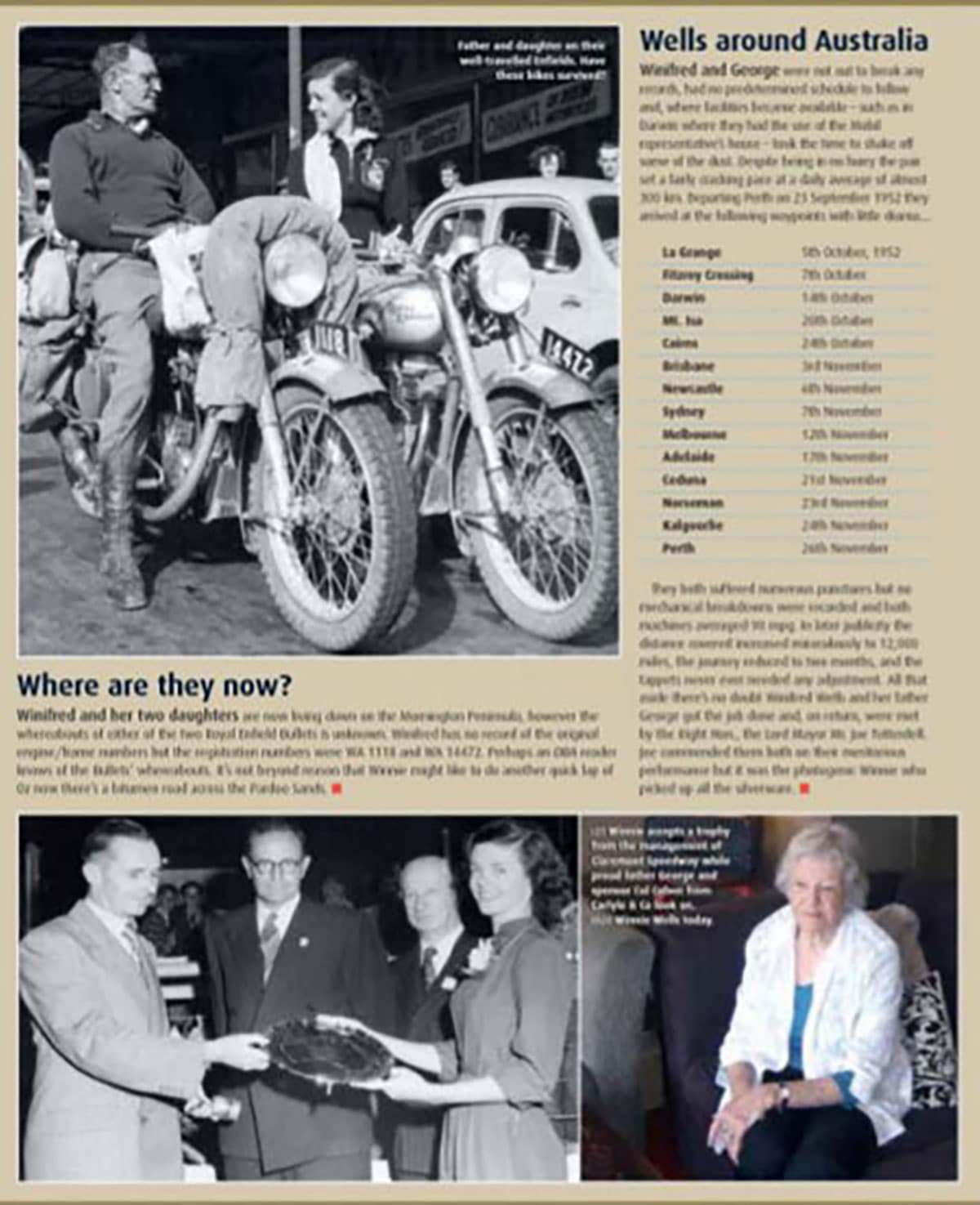
Picture top left: Father and daughter on their well-travelled Enfields. Have these bikes survived?
Picture bottom left: Winnie accepts a trophy from the management of Clarement Speedway while father George sponsor Col Cohen from Crlysle and Co look on
Picture bottom right Winnie Wells today
Published with the kind permission of Jim Scaysbrook, OLD BIKE AUSTRALASIA magazine.
Views: 404
